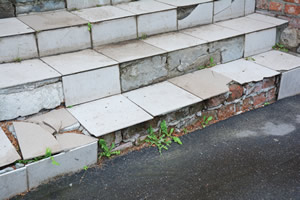Facilities (Campus Spaces)
Dealing With the Deferred Maintenance Challenge

PHOTO © RADOVAN1
Deferred maintenance has become a growing problem in the higher ed community, and it doesn’t take a presidential commission to determine why. During economic downturns, funds that might otherwise be used for this purpose offer a ready option for redirecting resources. Even when times are better, internal competition for dollars can be fierce, with building maintenance often taking a back seat to more pressing, or simply more visible, needs.
While some institutions have avoided this problem, it’s no secret that the backlog of deferred maintenance represents one of many threats to campuses everywhere, according to Bill Hoare, associate vice president for business at Carthage College in Kenosha, WI.
“For more than a generation, college and university administrations have been subsidizing their annual operating budget by neglecting their physical plants,” he says. “Aging physical plants and their associated risks represent a clear threat to campus operations all over the country.”
And yet on campuses large and small, aging buildings are a common reality.
“Almost every higher education institution in the United States is faced with the dilemma of aging facilities,” says Tammy Fulop, vice president, Schneider Electric. She notes that many buildings were built between 1950 and 1965, an era when construction quality was often sacrificed for speed. “These buildings are either nearing or already have reached critical life-cycle thresholds and are in need of renewal or replacement.”
For higher ed leaders, the current question isn’t so much why deferred maintenance backlogs have occurred, but how best to address them.
At Carthage, the commitment to maintain the physical plant has included utilizing the building subsystem life-cycle model in recording and monitoring “known issues” or deferred maintenance. Facility planners have also embraced national standards such as the ASHRE Life Cycle Chart and the GSA Facility Standards for Public Buildings to support life-cycle calculations. This information has been coupled with a four-step priority position statement for evaluating capital investments.
Hoare reports that over the past 20 years, the college has nearly doubled the gross square footage (GSF) of the campus, including the addition of six residence halls. During this period of new facilities investment, it became apparent that funding to maintain existing or legacy GSF lagged behind.
“This made strategic investment in the renewal process even more important,” Hoare says. “Communicating the state of the physical plant, as the largest single asset of the institution, to Carthage leadership is a critical function of the facilities department.” A plus at his institution, he adds, is that college leaders have both academic and campus operational experience. When combined with a knowledgeable board of directors, a shared understanding on the state of the campus was reached that included a commitment toward funding for the school’s recognized backlog.
“The facilities staff is now energized toward achieving a much higher level of renewal projects as reinvestment in the physical plant,” Hoare says. “This engagement of our campus leadership promises to reinforce that stewardship of the physical assets of the college should be a concern of the highest level of campus governance.”

PHOTO © 7TH SON STUDIO
The school is now in the preliminary stage of a campus master planning process, which is expected to provide the guidepost for future capital investment in facilities and hardscapes, according to Hoare. “This process will provide guidance for adaptive reuse of our existing facilities, thus gaining valuable resets of the life cycles of building subsystems while at the same time supporting the strategic vision of the campus,” he says.
He notes that the aging physical plant represents a portfolio of opportunities for energy and other operational cost savings due to capital investment, systems replacement, and even finish-level upgrades.
“Facilities professionals must examine both supply- and demand-side opportunities that utility tariffs may provide,” he says. “Natural gas hedging is still an effective but rather mature tool. Now, energy asset concession/thermal service agreements, energy savings performance contracts with third party verification and guaranteed results are becoming more common.”
Diverse Needs
In many cases, upgrades are directed not just to the more obvious targets such as walls, roofs, and windows, but also to core systems such as HVAC, lighting, electrical, and communications, according to Fulop. She reports that one of her company’s clients, the University of North Texas in Denton, gained a 31 percent reduction in energy costs, equal to $14 million in savings, as a result of two energy savings performance contract (ESPC) projects.
One of Texas’ largest universities, the university has 54 buildings in 12 colleges and schools. To achieve its goal of a “climate neutral” campus, the school underwent a series of renovations and energy upgrades, which included retrofits to the learning environment and direct digital controls for improved comfort. The university also installed variable frequency drives for better air flows, improved lighting systems, and other equipment and systems upgrades.
Taking a life-cycle-focused approach to planning and prioritizing deferred maintenance needs, including those for equipment, can have a tremendous impact, according to Spencer Morgenthau, director of business development for Southland Energy.
“By implementing improvements that drive down operating, energy, and maintenance costs first, universities can reallocate dollars wasted on inefficient equipment and reallocate these dollars for future capital maintenance needs,” he says.
Morgenthau adds that another approach is to bundle capital maintenance needs with fast-payback energy measures to create an impactful project that will offset all costs with savings. ”Much like an energy performance contract, this approach encourages decision makers to reinvest savings back into the deferred maintenance challenge,” he says.
Looking Forward
At Lycoming College in Williamsport, PA, the use of endowed funds has helped address maintenance needs over three decades. In 1990, the college and its trustees established a plant fund in the school’s endowment to have permanent resources for deferred maintenance on campus.
“Through this fund, the college is able to maintain and enhance its physical plant in a way that reduces tuition increases and without putting the burden of these costs on current students,” says Chip Edmonds, executive vice president. “In essence, students are able to benefit from first-rate facilities for which they do not directly pay.” Currently, the plant fund represents approximately 22 percent of the institution’s endowment.
In addition to the plant fund, Lycoming includes funding for deferred maintenance projects as part of its annual budget. Such needs are also addressed through philanthropy and charitable giving, according to Edmonds. When gifts are made to name new buildings or support construction, the college takes a portion of those gifts to establish new endowed funds dedicated to long-term maintenance for that building.
Hoare says that in a time of limited financial capital resources, when allocation of scarce resources defines economic ecology, it is the responsibility of facilities leaders to champion for the maximum ROI from use of physical assets.
“Using benchmarks, building aging statistics, facility condition indexes and/or life-cycle cost models should be the language of rational justification for financial stewardship,” he says.
He adds that facilities professionals must have intimate knowledge of the campus physical plant, not just in its condition but also in its effectiveness to support the critical campus missions.
“Maintaining an indexed campus space model and understanding how your campus physical assets are allocated toward goal driven purpose must be a stewardship requirement,” Hoare says. “Examining space utilization statistics and championing efficiencies is simply another form of financial stewardship.”
DEFERRED MAINTENANCE: DO STUDENTS NOTICE?
First impressions matter. Staff involved in recruitment will confirm that first-time visitors, including potential students or employees, respond to what they see and experience when they step onto campus. But once they enroll or are hired and are settled in do they start to overlook the faded walls, cracked sidewalks, overgrown hedges, stained ceilings, the odd toilet that doesn’t flush?
Students at Brooklyn College in New York don’t. They are blogging and posting to Instagram and Facebook about what they see as the crumbling infrastructure on their campus. Nicknaming the school “Brokelyn College,” they have shared photos of broken floor tiles, leaky ceilings, broken elevators, a cockroach in the library, ants crawling on garbage in a cafeteria, nonfunctional restroom fixtures, and more.
The “Fixing Brokelyn College” Facebook page exists “to raise awareness for Brooklyn College’s Broken facilities. To fight for funding!” The photos on the Facebook and Instagram sites speak for themselves.
Brooklyn College students are aware of the funding challenges their institution faces, and they are working with campus administrators to help solve the problems.
Students notice.
This article originally appeared in the College Planning & Management May 2018 issue of Spaces4Learning.